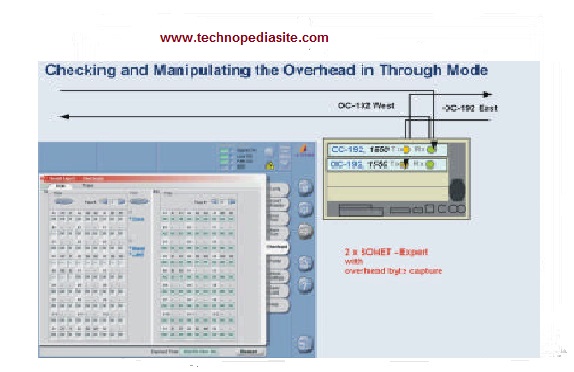Posted By: technopediasite.com
Checking interoperability
As at the termination points of digital spans, equipment from different manufacturers is frequently used. This raises interoperability issues requiring resolution to ensure seamless network performance.
Above figure illustrates how measurement equipment can be inserted into the digital span in through mode.
In below figure shows in detail how the bi-directional traffic is simply looped through the measurement instrument so that the payload traffic is not affected at all. The instrument must of course be equipped with both multi-port (2x TX and 2x RX) and through-mode capabilities to perform this task.
As exemplified in the above figure, the measurement instrument monitors the overhead of east-west and west-east simultaneously. As well as monitoring overhead, the operator may insert anomalies in the west-east direction to determine - via overhead of the east-west connection - whether the eastern NE reacts correctly. The above setup could be located in a single POP or distributed over two POPs. The instrument can be inserted anywhere within the digital span (POP or field), but would most commonly be located at the POP.
Interoperability checks are heavily scrutinized in lengthy evaluations at the VC. Using the above through mode evaluation with instruments capable of multi-port and remote operation, certain aspects of VC evaluations could be moved directly into a field trial. This saves time in the VC, makes node equipment available much earlier and reduces overall costs. The checks can be performed via LAN thus reducing and in some cases eliminating travel costs altogether.
Checking Automatic Protection Switching (APS)
Checking automatic protection switching (APS) performance is an essential test in SONET/SDH rings as it ensures network performance even if a particular connection in the ring fails completely. Should this occur, APS allows network nodes to route automatically to alternate paths without affecting the payload traffic. APS can be checked with the same through mode setup discussed in the above figure through mode & byte capturing. In an APS application, the span shown in the figure would represent a segment in a SONET/SDH ring.
In a test setting, APS could be activated with a physical interrupt of the west-east-link by generating an event in the west-east module of the measurement equipment. This can also be achieved by accessing the network management setting of the eastern node. In order to initiate the western node to route to the alternate path, the eastern node is expected to react with appropriate signaling according to the APS protocol. This can be observed by changes in the overhead of the east-west link.
Using test equipment capable of remote operation through an Internet browser is of great advantage as it allows access to both the network node (network management setting) and the measurement instrument simultaneously from the same terminal. Multi-port equipment can also monitor west-east and east-west links at the same time. Simultaneous views of all these aspects help the CO staff perform APS protocol checks in a more efficient and effective manner.
Checking interoperability
As at the termination points of digital spans, equipment from different manufacturers is frequently used. This raises interoperability issues requiring resolution to ensure seamless network performance.
 |
| Checking interoperability |
In below figure shows in detail how the bi-directional traffic is simply looped through the measurement instrument so that the payload traffic is not affected at all. The instrument must of course be equipped with both multi-port (2x TX and 2x RX) and through-mode capabilities to perform this task.
 |
| Checking interoperability |
Interoperability checks are heavily scrutinized in lengthy evaluations at the VC. Using the above through mode evaluation with instruments capable of multi-port and remote operation, certain aspects of VC evaluations could be moved directly into a field trial. This saves time in the VC, makes node equipment available much earlier and reduces overall costs. The checks can be performed via LAN thus reducing and in some cases eliminating travel costs altogether.
Checking Automatic Protection Switching (APS)
Checking automatic protection switching (APS) performance is an essential test in SONET/SDH rings as it ensures network performance even if a particular connection in the ring fails completely. Should this occur, APS allows network nodes to route automatically to alternate paths without affecting the payload traffic. APS can be checked with the same through mode setup discussed in the above figure through mode & byte capturing. In an APS application, the span shown in the figure would represent a segment in a SONET/SDH ring.
In a test setting, APS could be activated with a physical interrupt of the west-east-link by generating an event in the west-east module of the measurement equipment. This can also be achieved by accessing the network management setting of the eastern node. In order to initiate the western node to route to the alternate path, the eastern node is expected to react with appropriate signaling according to the APS protocol. This can be observed by changes in the overhead of the east-west link.
Using test equipment capable of remote operation through an Internet browser is of great advantage as it allows access to both the network node (network management setting) and the measurement instrument simultaneously from the same terminal. Multi-port equipment can also monitor west-east and east-west links at the same time. Simultaneous views of all these aspects help the CO staff perform APS protocol checks in a more efficient and effective manner.




0 Comments